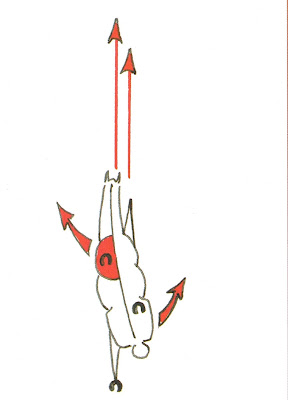Once the horse is able to achieve the canter strike off and maintain the canter for some time they:
•Understand the leg aid
•Are balanced correctly for the transitions
•Are relaxed in the transitions and the canter
•Understand the hand aid
Then it is possible to start working on Flexibility within the canter. Developing the possibility of moving the shoulders and quarters.
Natural Asymmetry affects the Canter
Horses are naturally asymmetrical. A horse which is naturally bent to the right will find it easier to canter to the right but will tend to weight its outside shoulder and swing its quarters to the inside (carrying the inside hind leg to the right). Some horses may even refuse to canter to the left. The diagram below shows a horse in Right Canter who naturally carries their quarters to the right.
Changing the lateral flexion in Canter
To improve the canter you need to do exercises with your horse to address their natural asymmetry, encouraging the horse to reach under their body with their inside hind leg and free up the movement of the inside shoulder. This can include canter in a slight angle of Shoulder-in or by doing neck rein turns in Counter Bend.
The diagram below shows some possibilities for improving canter by changing the bend of the neck
1. For a left canter the horse will tend to naturally bend the neck to the right
2. By bending the neck to the left the rider restricts the movement of the left foreleg
3. By bending the neck to the right the rider extends or amplifies the movement of the left foreleg
The rider can change the amplitude of the movement of the forelegs through bending the horse’s neck in canter. As with walk and trot the horse should become used to changing the bend of their neck in canter.
Counter-bend turns in Canter
The rider’s leg position (inside leg at the girth and outside leg behind the girth) must always stay with the canter lead but the horse can learn to canter counter-bent on circles and straight lines. Do turns in counter-bend using an outside neck rein (as in walk and trot). This helps the horse to free the movement of the inside shoulder and teaches the horse to bring the weight towards the inside shoulder with the shoulders in front of the quarters.
Christine Mogensen - Principal, Blinkbonnie Equestrian Center
Note : This theory note draws strongly on the information found in Philippe Karl’s “Twisted Truths of Modern Dressage”




Comments
Post a Comment